Would You Like a Coffee With That?
New Zealand is making a name for itself and it has nothing to do with great hiking and snow skiing. In the competitive world of advertising one local agency has risen to the top with this clever, aggressive campaign for an Auckland coffee house. The agency, Draft New Zealand, dreamt up the idea of placing branded trashcans – which looked like coffee cups complete with a stir stick outside competing cafes throughout the city, including Starbucks. Word has it that the chain store giant in particular, didn’t appreciate the dose of friendly jousting. Ouch
Tuesday, November 07, 2006
Would You Like a Coffee With That?
Posted by
Just Cool
at
4:12 AM
![]()
Monday, October 16, 2006
Corrugated cardboard house painting
Corrugated cardboard house painting
These photos show painted cardboard shelters in the homeless city that took root in the underground sprawl of Shinjuku station’s western wing in the mid-1990s. A deadly fire swept through the community in February 1998, forcing the inhabitants out and conveniently allowing the city to proceed with long-awaited plans to construct the moving walkway that now exists there. The paintings were also lost in the fire.
The cardboard house painters were Junichiro Take, who once spent 22 days in jail for performing his art in Shinjuku station, along with Takeo Yoshizaki, Yasuhiro Yamane, Itohisa Takano and others. Check out the full gallery here and read more background information here.
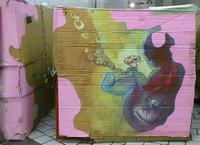

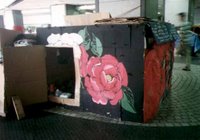


See more photos at Eyedia’s gallery of Shinjuku cardboard house paintings.
[Via: No-sword]
Posted by
Just Cool
at
12:04 AM
![]()
Wednesday, October 11, 2006
Sculptures made from oranges
Amazing art made from oranges
Most of us are fruit lovers. Creating gigantic art pieces with fruits, how about that? These sculptures are made from oranges. Click on the following links to see more.



Posted by
Just Cool
at
6:23 AM
![]()
Wednesday, September 27, 2006
Art... Made from toast!
MAKE: Toast art
The best art since sliced bread? Gavin Harper, our mate who has written articles on Build Your Own Band Aid Fuel Cell, Make a Geodesic Dome, and a number of cool tech books, met up with acclaimed "Toast Artist" Lennie Payne, who gives MAKE: readers some insight on how to make art from toast...
I met up with innovative artist, Lennie Payne who has been telling me all about how to make art from bread. The process is a fantastic way of self expression using white bread, a blow torch and scraping instruments to create pictures in toast.
It's the sort of thing that I thought you MAD makers would like to have a go at from the comfort of your own back yard, and I am well aware that excuses to burn things are always needed. So here ya go... a great excuse to play with some propane.
Paint gets a bit boring and samey after a while, so I am sure that any intrepid Makers/Crafters (delete where applicable) would like to try this bold new process. However, rest assured, it's harder than it looks! I struggle to make good ol' plain toast without burning it, never mind creating pretty patterns.
Lennie's website, http://www.toast2art.co.uk/, gives lots of details about the works that Lennie has undertaken, and could provide some inspiration for MAKE readers. Lennie has done works of Elvis Presley, Marc Bolan, and British Comedian, Benny Hill. You can find more inspiration on Lennie's artwork page at http://www.toast2art.co.uk/artwork.html.
If you would like an original quality piece of art, Lennie is available for commissions, you can contact him at toast2art@aol.com.
If you want a bit of variation, I suppose there is nothing to stop you using sun-dried tomatoes, or granary bread with seeds .
Lennie explained the process to me:
"When bread is dry, it won't degrade or go mouldy, so by flattening the bread, and then lacquering it, to keep the moisture out, the bread stays dry and wont rot. This is done after the bread has be toasted. You use a gas blowtorch to scorch the bread and turn it black, and then scrap away the burnt bread to create different tonal values., once the bread is lacquered on all sides, which helps to vitrify the bread, it is stuck onto a base with some silicone adhesive."
Lennie is soon to appear on BBC's Inside Out, who recently made a programme about him and his work, he has been featured in a number of UK newspapers and magazines, who find his work eye-catching and innovative. He has appeared on radio and TV in the UK and is quickly gaining an international following.
My final questions were "Is there much dough in it", having clearly heard it before, Lennie replied obviously having heard the comment several times before, "I manage to earn a crust".
Posted by
Just Cool
at
1:33 AM
![]()
Monday, September 25, 2006
GOOGLE VISION - POINT AND AIM
GOOGLE VISION - POINT AND AIM
Get lost? Do you? Well, yet another bright young designer from the U.K is developing a system that will have tag and name exactly what your staring at. Google Vision is a conceptual product developed by Callum Peden, for the worlds favorite search engine. The product provides the user with a truly unique information hub by combining GPS, OLED technology and advanced image recognition in the form of a retractable screen device.The Global Positioning System will see the end of wondering the streets asking for directions and the small roller ball will allow for easy navigation of the flexible screen. Brilliant for identifying landmarks whilst on holidays, Google vision acts as a personal; tour guide.As well as this, advanced image recognition will mean Google Vision can target well known landmarks. Then using the increased coverage of wireless internet, provide the user with information on their surroundings wherever they may be. by Andy
Posted by
Just Cool
at
2:40 AM
![]()
Wednesday, September 13, 2006
Carl Zeiss creates telephoto lens with 1700mm focal length
Carl Zeiss creates telephoto lens with 1700mm focal length
This new telephoto lens comes to us from the: "because we can" department. Lens manufacturer Carl Zeiss has just made one of the world's largest telephoto lenses -- it's so big in fact, that you nearly need a construction crane to lift it up. Weighing in at 256 kg (564 lb.), this monstrosity of a lens has a focal length of 1700mm (over 5.5 feet!), a speed of f/4, and has 21x magnification. You can't miss it if you attend this year's Photokina convention in Cologne, Germany starting September 29. Based on the company's press release, it sounds like it was custom-built for a client who wanted to shoot wildlife at a distance on the very high-end Hasselblad 203 FE using 6 x 6 medium format film -- in other words, she/he has some serious cash to spend. No word on if it will be ever made available to the public, but it sounds like Carl Zeiss is open to ideas if you've got a briefcase full of euros to pay for the project, not to mention the means to get it from wherever you are to wherever you actually want to use it without scaring every living thing in your path.
[VIA]
STL Sonnar T* 4/1700: Side View
STL Sonnar T* 4/1700: Topview
Posted by
Just Cool
at
8:07 PM
![]()
Tuesday, September 05, 2006
How to prepare stew for 30,000
How to prepare stew for 30,000
[Click on thumbnail for larg view]
At the Yamagata Imoni Festival (”Yamagata potato stew festival”) last weekend, 100 chefs gathered around a cauldron measuring 6 meters (20 feet) in diameter to prepare potato soup for 30,000 guests. The 18th annual festival organized by the Yamagata Chamber of Commerce and Industry was held on the banks of the Mamigasaki River in Yamagata prefecture.
As the centerpiece of a PR campaign to spur consumption of local agricultural products, the soup was made entirely from local ingredients, including 3 tons of taro potatoes (satoimo), 1.2 tons of beef, 3,500 blocks of konnyaku (yam paste), 3,500 leeks, 50 bottles of sake, 200 kilograms (440 pounds) of sugar, 700 liters (gallons) of soy sauce, and 6 tons of water. After the stew boiled for 4 hours, 2 backhoes were used to scoop it into smaller cauldrons for easier serving. The soup was reported to have a refreshing soy sauce flavor.
A separate batch of miso-flavored potato soup with pork was prepared in a smaller cauldron measuring 3 meters in diameter.
[Sources: Yomiuri Shimbun, Chunichi Shimbun]
Posted by
Just Cool
at
3:36 AM
![]()
Wednesday, August 30, 2006
Pyramid-shaped watermelons
Pyramid-shaped watermelons
Toshimichi Boui (55), a Nara prefecture resident in the furniture business, is making a name for himself by successfully growing pyramid-shaped watermelons.
Each melon is cultivated inside a hand-made acrylic box from a very young age. The vines grow on a wooden trellis so that the melons can be exposed to full sunlight. This allows them to develop nice, evenly colored rinds.
“Next year I hope to grow melons shaped like gourds and bottles,” says Boui.
The melons are lacking in flavor because they are unable to fully mature, so Boui has put them on display at the neighborhood hair salon, among other places. “You taste them with your eyes,” he says.
[Source: Asahi Shimbun]
Posted by
Just Cool
at
7:09 AM
![]()
Sunday, August 20, 2006
Sony Transparent TV
Sony Transparent TV
No kidding! This “transparent” TV really exists, and it’s from Sony. Look at the screen, it’s like floating…and the speakers, freaking awesome!
[Click On thumbs for larger view]




Posted by
Just Cool
at
7:42 AM
![]()
Saturday, August 12, 2006
Ant Farm
Ant Farm
We all remember the old style ant farms… This new version looks nothing like the old ones, someone needs to set up an ant cam using one of these things. “Fascinating creatures ants. Sure you hate to see them in your socks or making a B-line for that pizza crust crumb you forgot to sweep up at the local LAN party. But let’s give credit where credit is due. Ants are amazing. Ants can lift up to 20x their body weight! They have two stomachs and three eyes! They also have uncanny communication skills and amazing abilities to work together to achieve a common goal.
This miraculous gel, derived from a NASA Space experiment, serves as both habitat and nutrition for your ants - allowing you to watch in awe as they turn a brick of aqua-blue gel into a fascinating colony of tunnels. Never before have you been so capable of watching these awesome creatures at work. ”Via: PopGadget

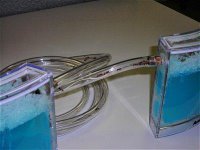


Posted by
Just Cool
at
12:32 AM
![]()
Monday, July 24, 2006
Holy keyboard to hit Japan soon
Holy keyboard to hit Japan soon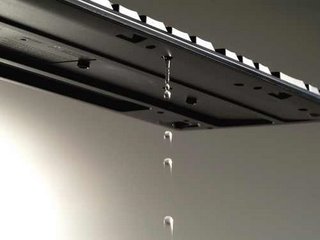
In what's not being hailed as a revolutionary breakthrough, a Japanese company called Sigma A.P.O has developed a spill-resistant keyboard that's got holes drilled in it to let the coffee, beer, juice, etc. escape.
Now that's what you'd call a cunning plan! The other great thing about the WRKB108 is that the keys are coated with some special form of UV paint that makes them super strong, dirt repellent and, we hope, able to keep their identification. Unlike some keyboards we could mention. In fact, you can hit them 5 million times, claims Sigma, without wear and tear.
The keyboard is remarkably keyboard-sized and -shaped and weighs in at 650g. The WRKB108 will cost ¥2,980 when it goes on sale next week.
(Via Sigma A.P.O [Japanese, PDF])
Yoshi's take: I'd like to meet the guy they paid to hit this thing 5 million times. Oh wait, no I wouldn't.
Posted by
Just Cool
at
3:31 AM
![]()
Sunday, July 16, 2006
Sao Tome e Principe works with technology
Sao Tome e Principe works with technology
I know, I know - enough USB stuff already, but this is a little different:
Sao Tome e Principe is a West African country with a population of about 150.000, located on the Guinea Gulf along the Equator. SEED 2006, a Design and Social Economy project financially supported by the Portuguese Cooperation and developed by designer Pedro Alegria, introduced USB flash card design to local craftsmen, all of whom had never seen or heard of such things before. The end result merges traditional "forgotten" craft with hot technology on the rise, sustaining the working families' needs and offering unique craft-designs to the masses.
The project is currently seeking large orders to maintain and increase production.
VIA.
Posted by
Just Cool
at
7:56 PM
![]()
Sunday, July 09, 2006
Keyboard Food Tray Prototype, Genius
Keyboard Food Tray Prototype, Genius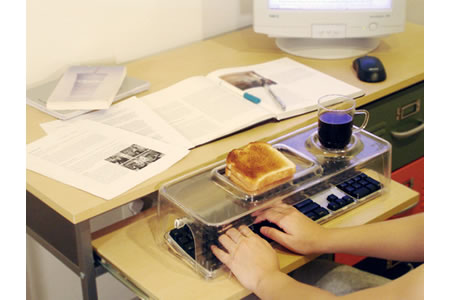
Many of us spend a lot of time working on the computer and sometimes we even have our meals while working. Due to the office supplies there is not enough space for food on the desk. Here is an ingenious design which makes use of the keyboard which occupies the max space on the desk. A food tray which fits on the keyboard and allows you to have food without any work interruptions.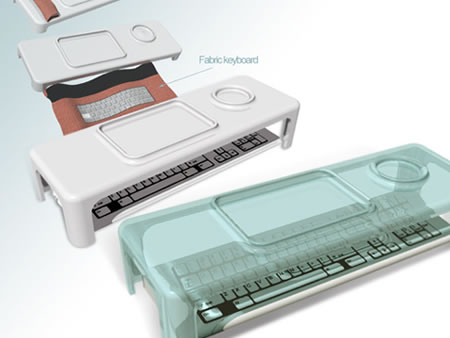
The Keyboard tray is designed by Duck Young Kong and is still to enter into production.
Source
Posted by
Just Cool
at
7:27 PM
![]()
Wednesday, May 24, 2006
How to run your own internet radio station
How to run your own internet radio station
If you've ever wondered how internet radio stations work and/or wanted to create your own, this tutorial will show you how. It is actually very easy, and you can set up your own radio station and begin broadcasting songs in about 10 minutes.
First of all, let me give you a quick rundown on how it works. You have your music player (I will use Winamp, get it if you don't have it) and you play your music as you normally would. Through a plugin (which you will download and install), Winamp will send the music you play to the broadcasting server (which can be on your PC or on another one with a larger connection), and the server sends the music to the listeners, reencoding it to a better format, if you are so inclined. Note that the amount of listeners you will be able to support is limited by your outgoing bandwidth and the bitrate of the song you are streaming, so if you're streaming at 128 kbps and you have 256 kbps upload bandwidth, you'll obviously be able to support 256/128 = 2 listeners.
The programs I use are Winamp for playing, oddcast DSP for broadcasting to the server and Icecast for serving. You can use Winamp's own Shoutcast plugin and server, but I prefer to broadcast in Vorbis because it's smaller and has much better quality than MP3.
Let's get started, then. Download Icecast from this page (you presumably want the Windows version) and install it. Run it and click "Edit configuration" in the "Configuration" menu. A notepad window will pop up with various configuration options. My configuration is this:
You can copy it and paste it in your file, but make sure you change "hackme" to more secure passwords. Once you have done this, save the file and close the window. Click the "Start server" button and the listboxes below should be populated with various information, like this: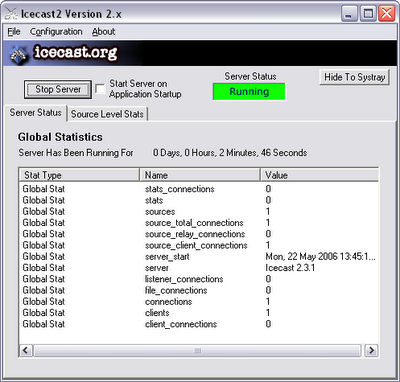
Your server is now ready for people to connect to it, but there's no music playing, so let's tend to that. Download oddcast for Winamp from this page and install it. Now, run Winamp, go to the "DSP/Effect" section of the preferences and click on "oddcast DSP v3". You should see the oddcast window pop up, looking something like this:
Click on "Add encoder" and a new encoder will be added in the box below. Right-click on it and select "configure". A dialog will pop up, asking for various information. For "Encoder type" select "OggVorbis" (or MP3, if you are so inclined), this will make you stream in Vorbis. Some people might not be able to have the available codecs if they're running a very old version of their player (all newer players worth their salt support Vorbis).
For "Quality" I have entered -2, it is the lowest quality, giving you about 30 kbps bitrate and very acceptable quality. You can experiment with 0 or 2, going over 6 is overkill in my opinion (since 6 is what I use to archive music from my CDs), and you will be able to support more listeners if you have lower bitrate for the song.
For "Server IP" enter the IP of the server you're running Icecast on (it's "localhost" if you're running it on your own PC). "Server port" is whatever you entered in the configuration, 8000 if you used mine, and "Encoder password" is hopefully something other than "hackme". I also use mono, because my connection only has 128 available upstream bandwidth and it doesn't sound too bad.
Click OK here and then click "Connect". If you did everything right, the encoder should now connect to Icecast and begin streaming, like so:
If you want to do a voiceover (speak in your radio) just click the Live Recording button and it will broadcast anything that you say in the microphone (or whatever you enter as the input device). Click on it again to return to your normal music (I haven't actually tested this, if there are any problems just comment here).
The "Source Level Stats" section of Icecast should also change to include your stream, and will look something like this:
You can now tell people to connect to http://[yourip]:8000/stream.ogg with their players, and that's all there was to it. Happy DJing.
Note: Before you broadcast any music, make sure you have the right to do so, otherwise you could be breaking the law of your country.
[VIA]:Poromenos
Posted by
Just Cool
at
12:03 AM
![]()
Tuesday, May 09, 2006
Flying suicide bomber drones could be almost unstoppable

Flying suicide bomber drones could be almost unstoppable
If you thought the 12-gauge shotgun-wielding AutoCopter was bad news, imagine one of the little menaces in the hands of a terrorist and strapped with several pounds of explosives -- or worse, biological, chemical, or radiological payloads. Several experts are warning that we are nearly defenseless against such attacks, even though terrorists have already shown a propensity for using such tactics in the Middle East and South America, and are known to have purchased so-called "drone" airplanes capable of high-precision navigation even over long distances. One scenario that is particularly disturbing involves a fleet of drones or robotic helicopters launched from an off-shore freighter, sent en masse to attack a large gathering like a sporting event where stampeding from panic would likely cause more deaths than the bombs themselves. The Pentagon is supposedly working on an drone-killing drone of its own, called Peregrine, that would patrol the skies and intercept any hostile aircraft -- but the main problem seems to be finding, not destroying these things, and you'd need a whole lot of Peregrines to cover every potential target in the US.[Via Phys Org]
Posted by
Just Cool
at
5:37 PM
![]()
Monday, May 08, 2006
Neptus 60 Cliff Habitat
Neptus 60 Cliff Habitat

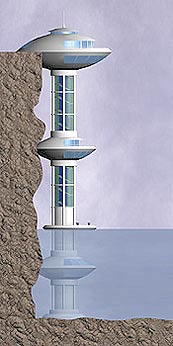
Neptus 60 is a Cliff-House designed by Naval Architect Giancarlo Zema and exclusive to Underwater Vehicles Inc. Neptus 60 has been conceived to create a cliff side environment in harmony with nature. It allows the occupant to fully enjoy the cliff placing, to admire the views on the sea and the spectacular underwater sea life. The project reflects on Neptus, the amphibious shellfish that once thrived in the oceans over 500 million years ago. Neptus 60 is made up of 4 elements: (1) living area (2) observation deck, (3) docking for boats, (4) underwater observation globe
The different floors are connected with a winding staircase that looks on the sea, and served by a glass elevator.
(1) Living area - Circular construction anchored on the cliff. It is divided in a living room with terrace and a night area with 3 bedrooms looking on the sea with inclusive ensuite bathrooms.
(2) Observation deck - Capsular layout hanging at 20m on the sea level. It allows you to look at the sea in a comfortable and private place.
(3) Docking for small craft - A wharf allows you to reach Neptus 60 directly from the sea.
(4) Underwater observation globe - The most interesting space complete with underwater lighting and diver lock-out options. Underwater components by renowned submarine manufacturer.
Technical characteristics
Carrying structure - that can be modulated, that can be anchored on every sort of cliff.Living area - diameter 18m, 250 square meters on two levels.Observation deck - 80 square meters on 2 levels.Wharf - 40 square meters.Underwater observation globe - 80 square meters om 2 levels completely underwater.Elevator lift capacity - 650 kg (6 people), speed 1.5 m/s, height 50 mt.
Posted by
Just Cool
at
12:57 PM
![]()
Thursday, April 27, 2006
Future Flying in Hamburg
Future Flying in Hamburg One of the biggest highlights of the show was the unveiling of the new cabin area for the Airbus a350. At a minidesk in the business corner, a passenger can get the same connectivity as on the ground.
One of the biggest highlights of the show was the unveiling of the new cabin area for the Airbus a350. At a minidesk in the business corner, a passenger can get the same connectivity as on the ground.
The Airbus a350 will be able to seat more than 300 passengers in three levels when it takes off in 2010.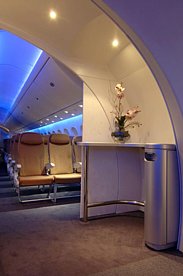
Airlines showed off their new passenger comforts at the Airline Interior Expo held in Hamburg, Germany, earlier this month.
The Airbus a350 will already have a competitor, the Boeing 787 Dreamliner, due in 2007. It will feature an on-board wireless in-flight entertainment system with a new configuration designed to reduce weight and let passengers easily conduct business and access entertainment while in flight. Windows on the Dreamliner will also be larger.
OnAir announced that it plans to release a GSM network for aircraft that will allow passengers to use their own mobile phones to send and receive calls and text messages.
TAP and Air France has signed up for the service which is scheduled to begin operations in 2007. OnAir is a joint venture of Sita Inc. and Airbus. Read the complete story here.

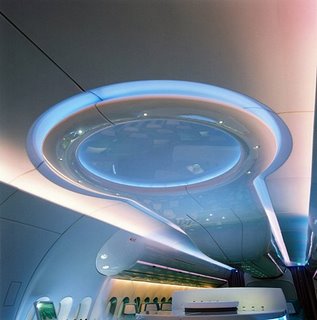
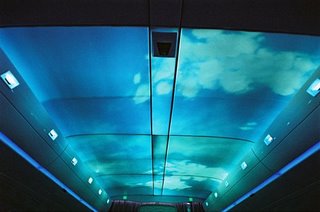

Posted by
Just Cool
at
10:47 PM
![]()
